The business model that has helped newspapers survive and develop for a long time is mainly advertising. In the context of increasingly difficult print newspapers, television and radio have also passed their glory days, especially in the past 10 years, when communication technology has become more modern with cheaper costs, most online newspapers also focus on advertising revenue with the hope that the "goose" will "lay golden eggs". As social networks develop rapidly along with the concept of "distributed content", press agencies realize that social networks can play an important role in spreading information, bringing in huge traffic. And of course, the hope is that advertising revenue will gradually increase - first display advertising, then automated advertising and sponsored content.
Press agencies race to get high traffic, especially traffic from external sources that depend on the algorithms of search engines and social networks, which not only reduces the quality of journalism, but also places too many advertising positions on the page and in the article, which also brings a bad experience to readers. When asked about some press agency leaders, they clicked their tongues: "There is no other way because we need to have a source of income."
However, at this point, it is clear that online newspapers relying on advertising and social networks will not be able to develop sustainably, and may even suffer serious consequences to the point of bankruptcy.
Friend or foe?
More than 10 years ago, there was a debate at many conferences, press seminars as well as in newsrooms around the world , whether social networks should be considered friends or enemies. Called "enemies" because social networks at that time "robbed" many readers and sources of revenue of press agencies, called "friends" because thanks to social networks, news websites attracted a significant amount of traffic.
Of course, everyone expects that high and growing traffic will mean increased advertising revenue, offsetting the decline in print advertising and circulation revenue.
Ultimately, the leaders of the press agencies concluded that social networks are both friends and enemies, the English term is called "frenemy", combining the words "friend" and "enemy". Social networks - which at that time were mainly Facebook and Twitter - although they posed many threats to the press agencies, they also brought many benefits, so a strategy to utilize social networks is an inseparable part of the operations of the newsrooms.
There has even been the concept of "social journalism" - that is, press agencies use social networks in every stage of the content production process: from collecting information, verifying information, supplementing information to releasing information.
Many newsrooms are so innovative that when they have breaking news, they post it on their Facebook fanpage or Twitter account first, then make the news on their news page.
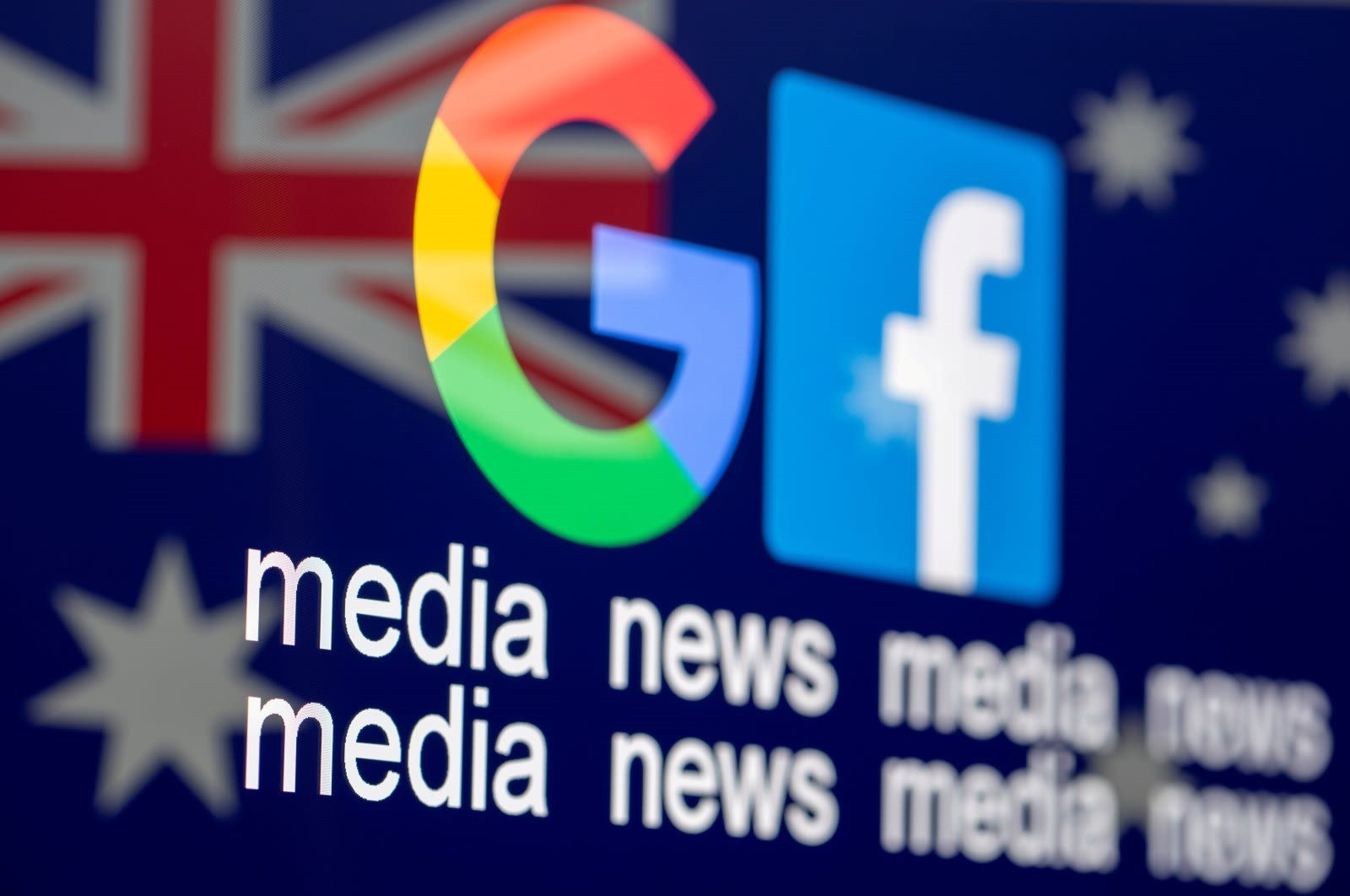
Over time, the relationship between newspapers and social media and search engines like Google has not been smooth.
The fears and excitement of the past have now given way to constant clashes, and collaborative projects between technology platforms and the press have given way to harsh statements and threats from both sides.
However, the disadvantage seems to be on the side of the press agencies. The money is little or none at all, and traffic has dropped dramatically.
Over time, the relationship between the press and social media and search engines like Google has not been smooth. Collaborative projects between technology platforms and the press have given way to harsh statements and threats from both sides. However, the disadvantage seems to be on the side of the press.
According to the latest surveys, traffic from Facebook to news agencies’ news sites has plummeted, while Meta – the social network’s parent company – continues its policy of distancing itself from the press. Data from reputable analytics firms Chartbeat and Similarweb last May confirmed the increasingly clear downward trend.
Of the 1,350 global news organizations that Chartbeat has data on, 27% of traffic from external sources, search engines, and social media in January 2018 came from Facebook, or 2 billion pages. By April 2023, that share had dropped to 11%, or 1.5 billion.
Although all media outlets are affected, the smallest ones are the hardest hit. A survey of 486 small media outlets (with an average daily traffic of less than 10,000 pages) found that Facebook traffic accounted for only 2% of their traffic in April.
For large press agencies (with an average of over 100,000 pages/day) the decrease was 24%, while for medium-sized newspapers (from 10,000 to 100,000 pages/day), the decrease was up to 46%.
Percentage of Facebook traffic in total visits from external sources/search engines/social networks of 1,350 press agencies from January 2018 to April 2024:
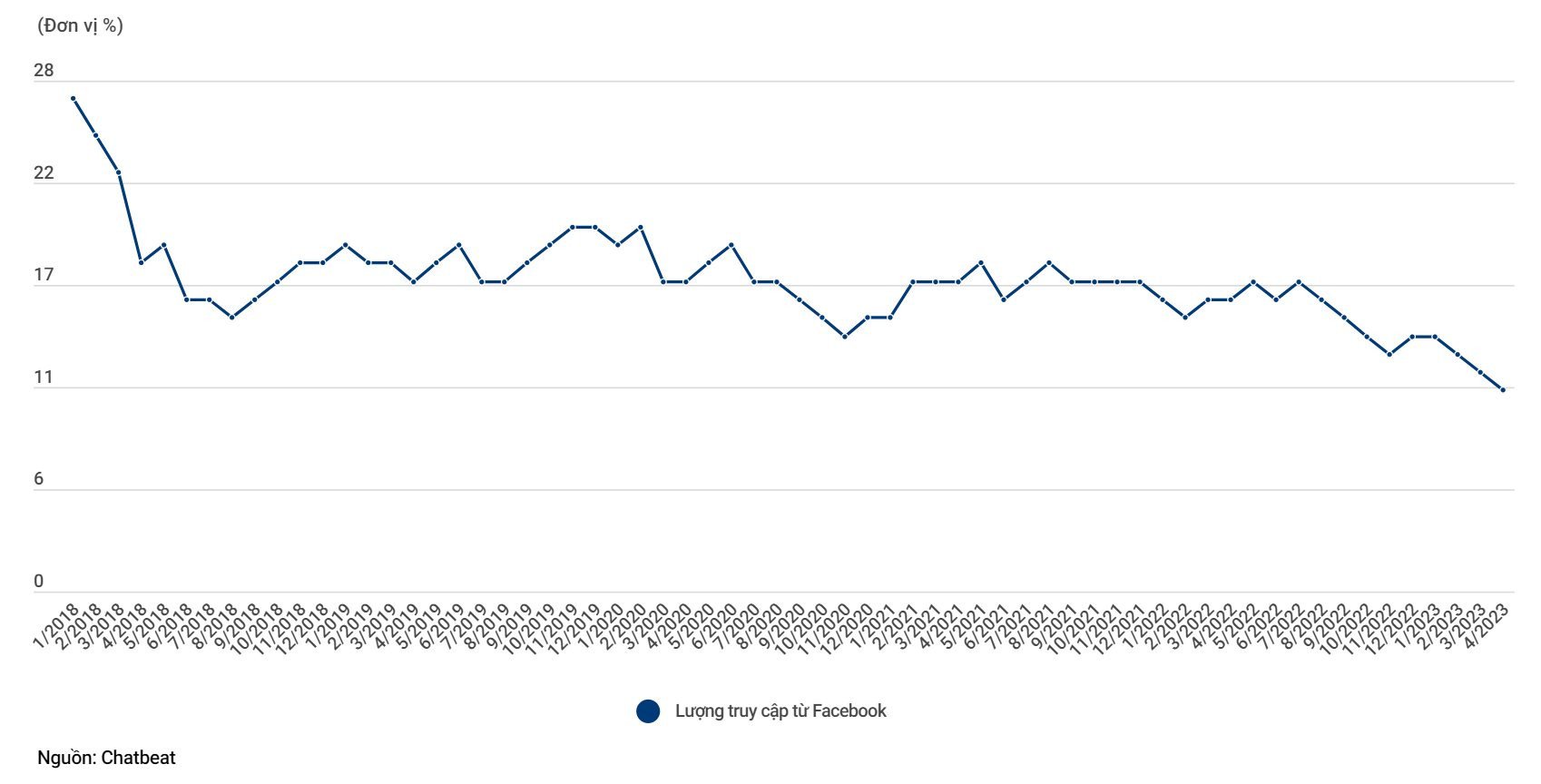
Earlier, Britain's largest newspaper group Reach said its digital advertising revenue in the first four months of 2023 had fallen 14.5% and it claimed the decline in traffic was due to "recent changes to the way news is displayed on Facebook".
Chartbeat data tracking 1,350 news sites also shows that traffic from Twitter, which was already small, accounted for just 1.9% of total traffic in April 2018 and dropped to 1.2% five years later, as of April this year.
A closer look reveals that small news organizations now have virtually no traffic from Twitter. There were just 186,930 page views in April for 486 small newsrooms (under 10,000 pages/day), down 98% from 10.1 million pages in April 2018.
The Covid-19 pandemic has devastated traffic to small media outlets. Even well-known media outlets have not been spared.
Among the 25 English-language news sites surveyed, the average decline over the two years from April 2021 to April 2023 was 30%.
Traffic from Facebook by scale of 1,350 press agencies from January 2018 to April 2023 (taking January 2018 as the benchmark = 100%):
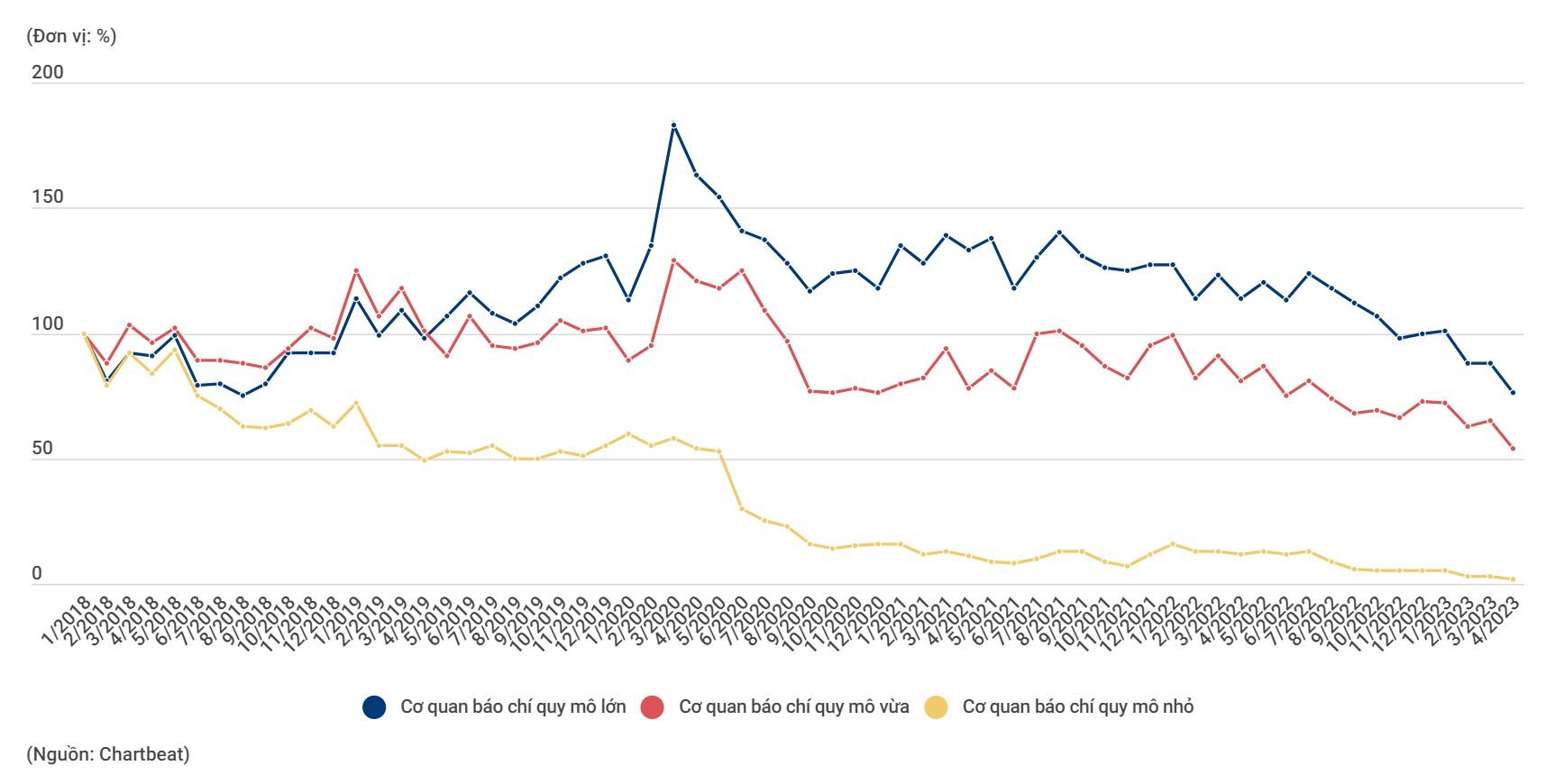
Facebook and the Fall of Buzzfeed News
Buzzfeed News' shutdown in April this year showed the risks of media outlets over-emphasizing their strategies for attracting traffic from social media platforms.
While Similarweb's social traffic data only counts desktop views, which are a small percentage of a site's overall traffic, the downward trend is clear.
In just two years, visits to Buzzfeed News from Facebook have dropped from 261,669 in April 2021 to 124,825 in March of this year, a decrease of 110%.
Buzzfeed.com has seen a similar decline, down 70% year-over-year. It’s worth noting that traffic from other social networks has also declined, but Facebook’s decline has been the biggest. In April 2020, Facebook desktop traffic accounted for 76% of Buzzfeed’s social network traffic. By March 2023, that figure had dropped to 34%.
Visits to BuzzFeed.com from Facebook and other social networks using computers, worldwide, April 2020–March 2023:
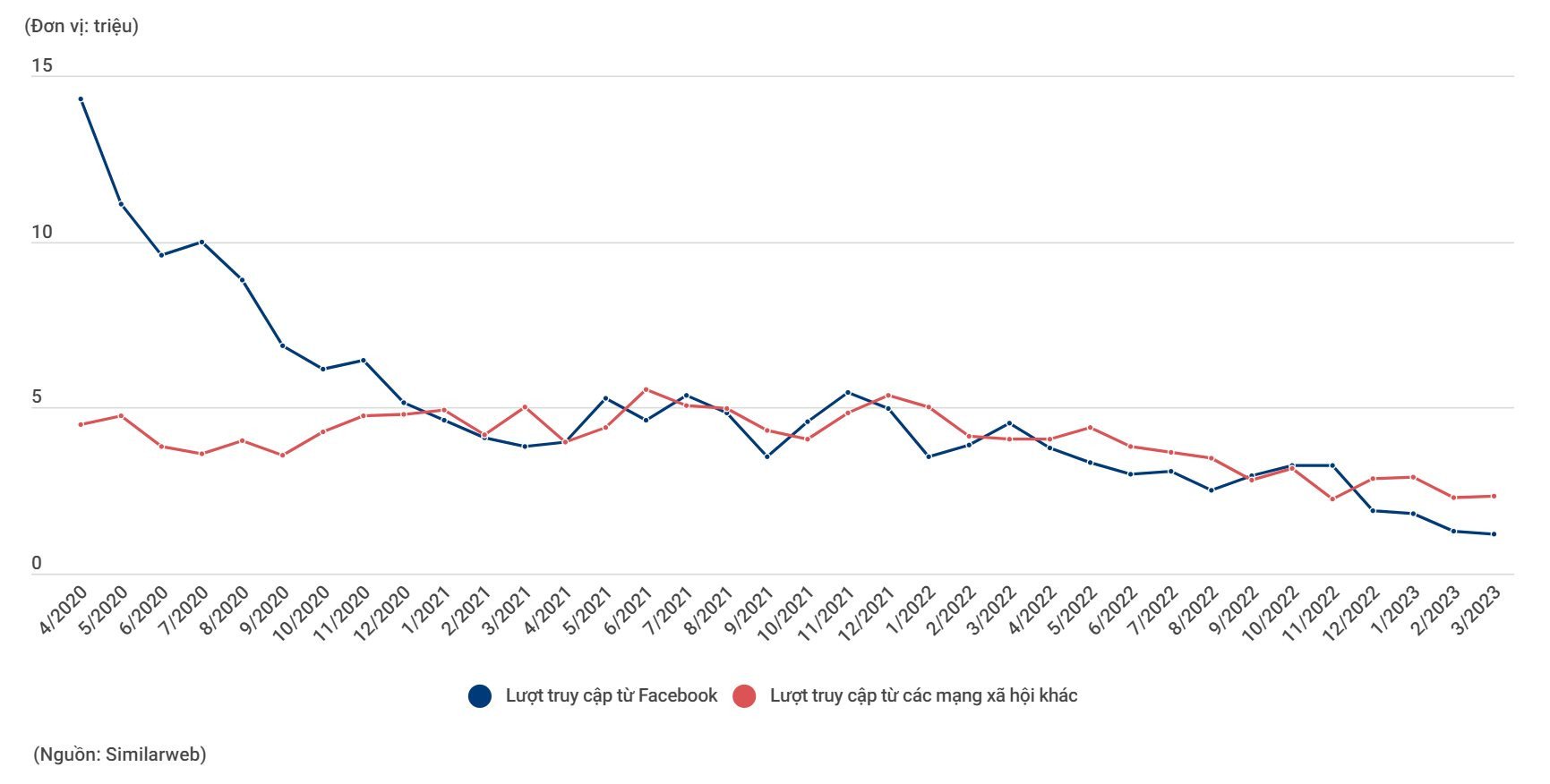
Facebook's diminishing role also affects the overall readership of news organizations that rely on social media.
According to Similarweb, Buzzfeed.com had 152.6 million visits two years ago, compared to fewer than 100 million in recent months. The news organization attributed the decline in user time spent viewing its content to Facebook’s changes.
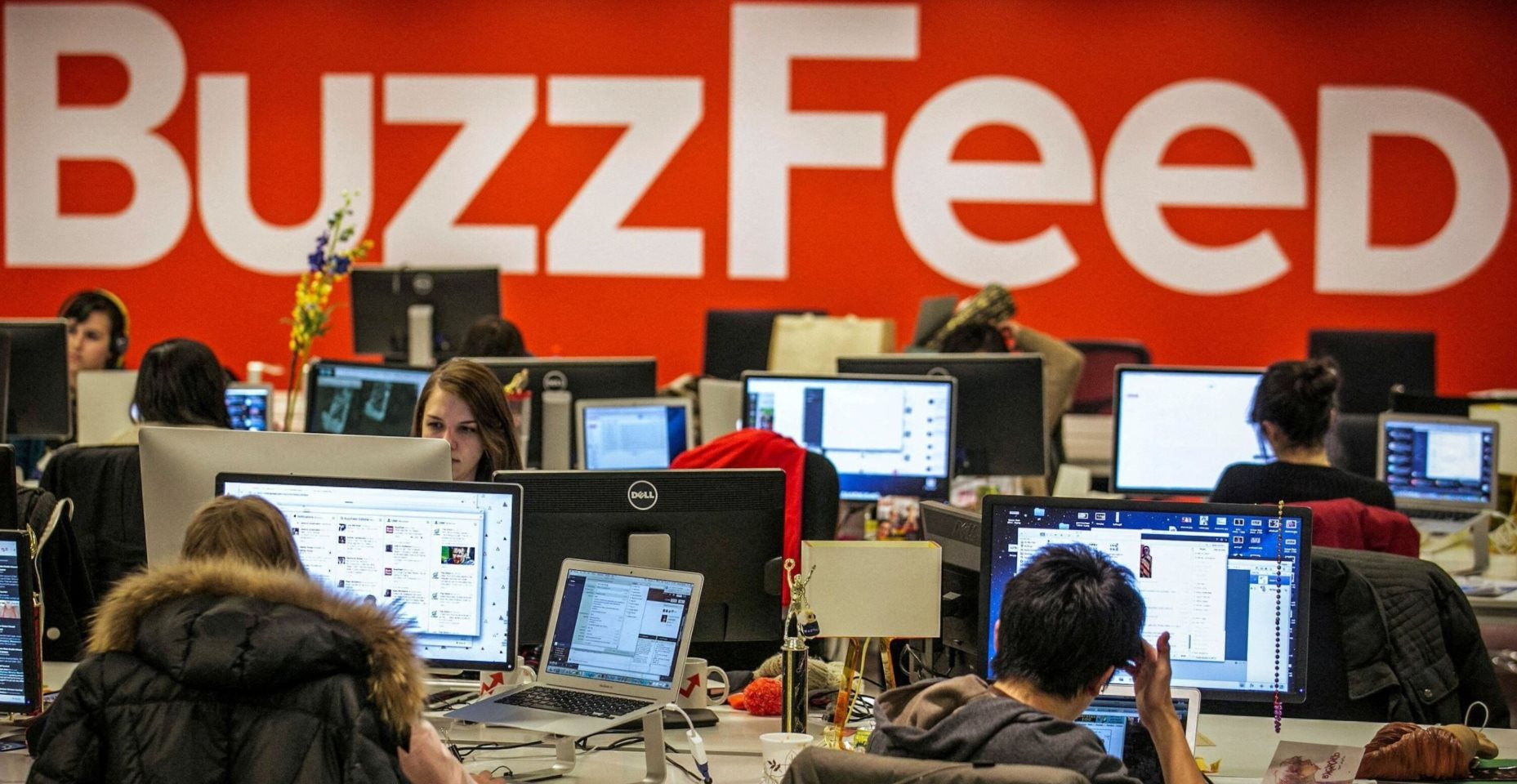
Recent changes to Facebook's algorithm and the platform's lack of prioritization of news have had a strong impact on news organizations.
A 2014 algorithm change to reduce clickbait hit viral-focused sites like Upworthy and Buzzfeed hard, and a 2018 update to prioritize content from “family and friends” in the News Feed was another huge blow to news organizations.
In 2022, Facebook announced it would be phasing out Instant Articles, which offered faster access to news in a friendly format right within Facebook's mobile app.
Facebook’s declining role has also affected the overall readership of news organizations that rely on social media. Changes to Facebook’s algorithm and the platform’s de-prioritization of news have had a significant impact on news organizations.
In April 2023, Facebook's parent company Meta released a report stating that news plays "a small and diminishing role" on its platform.
The report – released shortly after the UK introduced a new law that will force Meta and Google to pay news organisations for using news content – claims that news links account for just 3% of what Facebook users around the world see in their News Feed.
The report's authors also offered a "rough estimate" that news organizations on average earn only 1% to 1.5% of their total revenue from links back to their websites from content shared on Facebook.
Previously, at the end of 2022, Meta laid off a series of key personnel related to the news industry, an indication that the technology corporation was ready to part ways with journalism.
Among the senior staffers to leave are David Grant, who heads the Meta Journalism Project, and Dorrine Mendoza, who heads local news partnerships.
Among other journalism-related positions that were also fired were the head of news partnerships for Southeast Asia, a news program director, two news integration directors, and several others.
Similarweb data for 28 major news organizations also shows that traffic from Facebook to both print and online newspaper websites has dropped sharply.
Vice Group's popular lifestyle and young women's site Refinery 29 suffered the biggest drop, down 92% between April 2021 and March 2023. Reach's sites express.co.uk and manchestereveningnews.co.uk were next, down 87%.
In April 2020, 95% of Ladbible’s desktop social media traffic came from Facebook. In March this year, that figure was 49%. Visits to sun.co.uk also fell from 75% to 25% over the same period. For the Daily Mail, the drop was from 59% to 19%, but they gained traffic from Twitter and YouTube.
Let's learn about two famous newsrooms, once pioneers of innovation in journalism, but now one has had to close down, the other declared bankruptcy - a not-so-bright sign for the future of digital journalism.
Buzzfeed News: Even the brightest stars must die out
Buzzfeed News, the one-time shining star of digital journalism, has announced it is permanently shutting down its Pulitzer Prize-winning news division and laying off about 60 reporters, a move that founder and Editor-in-Chief Ben Smith described as "the end of the marriage between news and social media."
Anyone who studies modern journalism will surely know this once-famous name. Buzzfeed was once the "unrivaled champion" of viral news (spread on social networks), leading the genre of articles called "listicle" which was once considered a new innovation of journalism (like "5 ways to help women in their 40s stay in shape" or "10 places to travel this summer", etc.), and also violent, provocative and shocking content to attract views. But they still could not escape financial difficulties.
"I decided to invest so much in BuzzFeed News because I loved the work it did and its mission," Jonah Peretti, founder of Buzzfeed, told employees. "It took me a long time to come to terms with the fact that the big tech platforms would not distribute the content and provide the financial support necessary to promote free, high-quality journalism, produced exclusively for social networks."
The drop in traffic to the site is believed to be due to a decline in traffic from key sources like Facebook, which is largely due to Facebook's move to encourage users to watch and share videos like TikTok.
Visits to buzzfeednews.com from Facebook on computers, worldwide from April 2020 to March 2023:
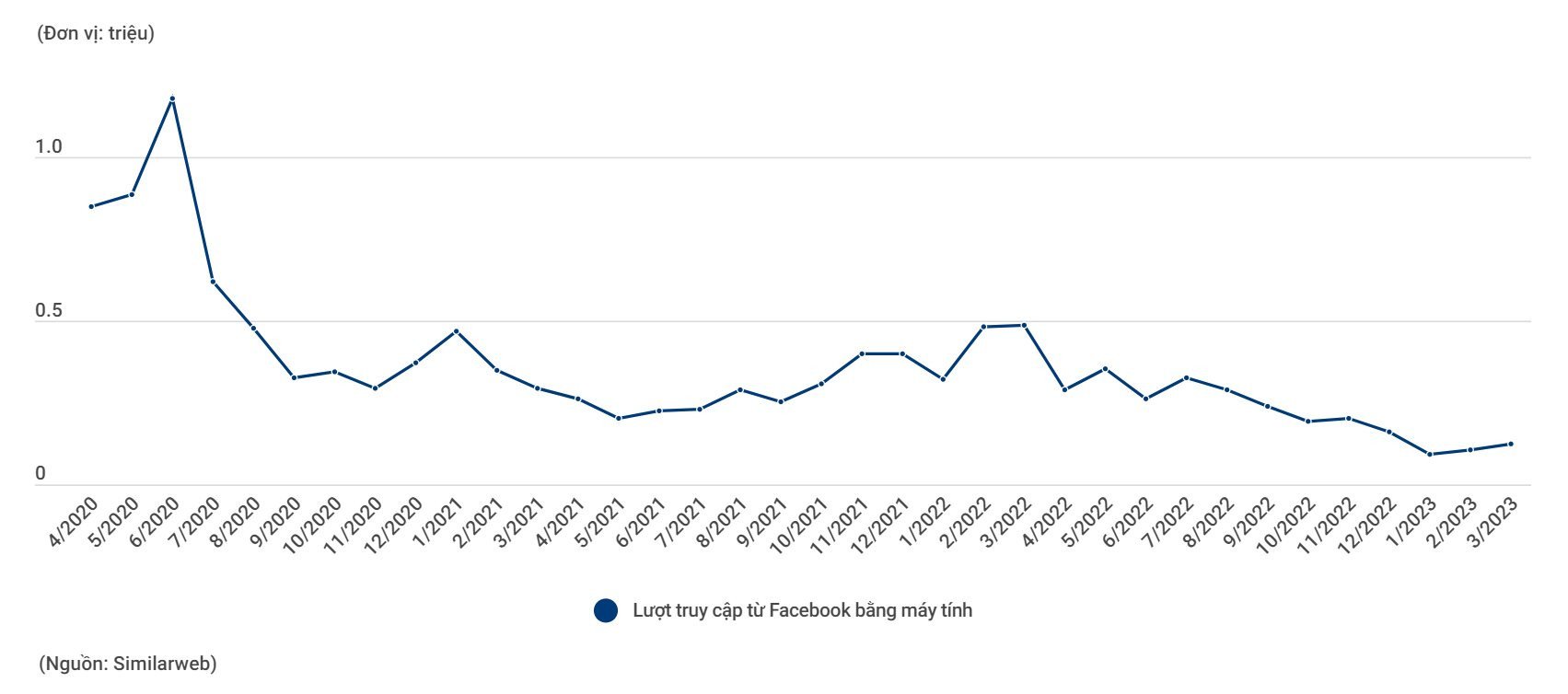
Less traffic means less advertising revenue. And less revenue led to the closure of Buzzfeed's news division, which in turn put many journalists out of work.
This is clearly bad news for everyone involved, and for the digital journalism industry more broadly. Buzzfeed News used to be a force for good, in-depth reporting, producing truly impressive journalism that even established, respected newspapers respected. They won numerous awards and the respect of their colleagues and readers. And now they can no longer survive.
Buzzfeed pioneered the use of viral content and helped legitimize it as a new form of journalism. Its early success – from the launch of Buzzfeed News in 2012 until the start of layoffs in early 2019 – inspired many other news organizations to create viral content of their own.
Think back to early 2013, when many newspapers were desperate to learn a piece of Buzzfeed’s magic. Trinity Mirror tripled its traffic overnight by launching UsVsTh3m and Ampp3d, which openly mimicked Buzzfeed’s informal, even vulgar, style.
The Sun's then-editor, David Dinsmore, called Buzzfeed "the best thing on the internet" and launched a similar product. Even the BBC, in a report by former Sony CEO Howard Stringer, urged its staff to be as different as Buzzfeed.
In the UK, The Independent's Indy100 page, with its shocking breaking news, eye-catching images and quizzes, is considered the UK's version of Buzzfeed.
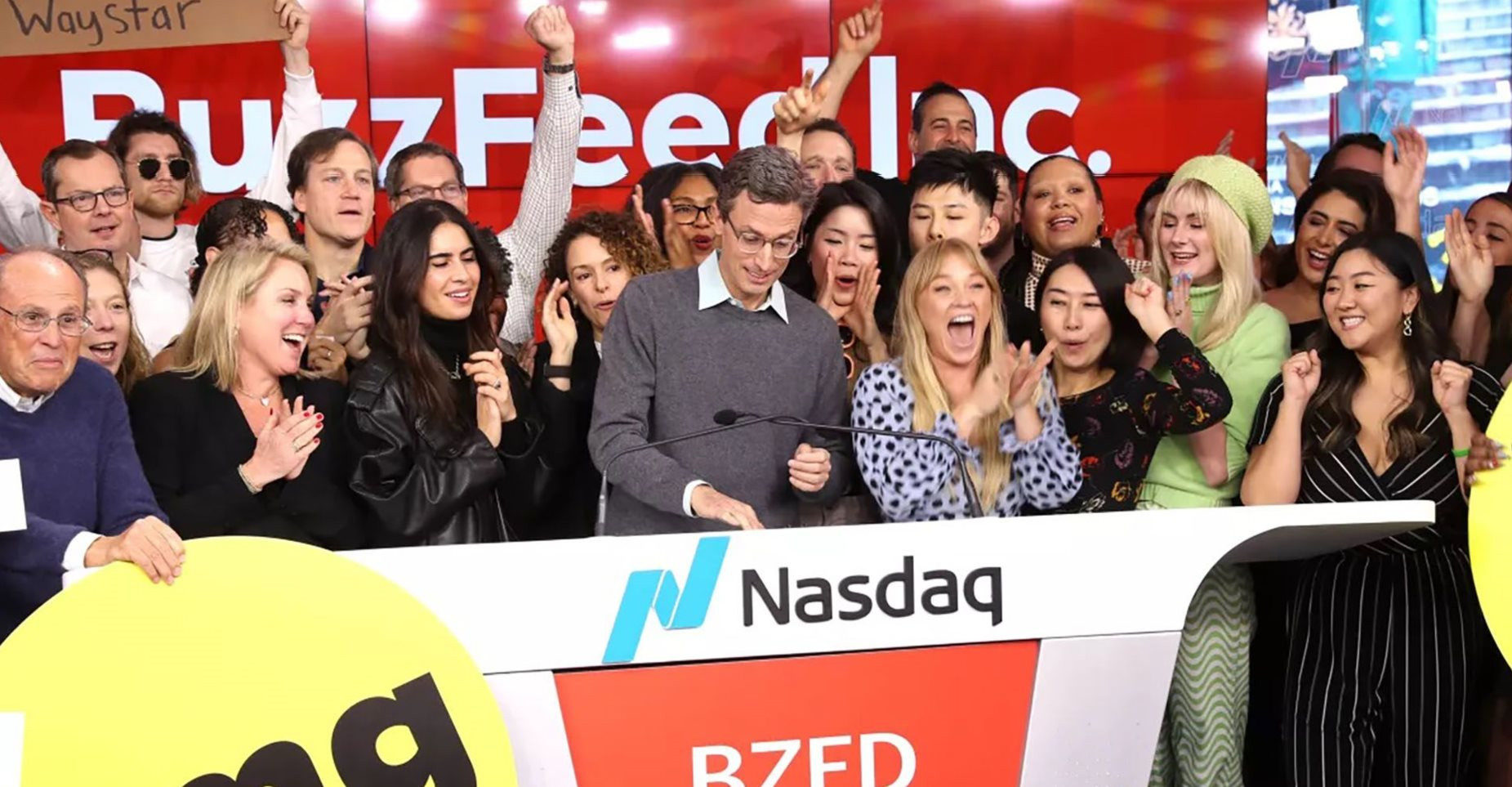
Of course, Buzzfeed was initially famous for its entertainment division, which used user-generated content, with "stupid" headlines like "10 cardboard boxes that look like David Cameron" (which has since been deleted) and equally shocking quizzes, but let's not forget that they also had some seriously impressive articles.
The news department is truly professional, winning the Society of Editors' award for best news website in 2018 and they also took home a Pulitzer Prize in 2021.
A study by Nanyang Technological University in Singapore found that BuzzFeed News' news influence is just as great as The New York Times, and the reason is that they have a team of "hard-core" journalists capable of creating high-quality journalism.
Another 2018 study by researchers at the University of Leeds found that Buzzfeed News reporters were as sharp and competent as traditional journalists, despite being relatively young and focusing on issues that resonated with readers aged 18 to 30.
This study, published in the journal Journalism Studies, shows that Buzzfeed News is not just a website with clickbait content but is actually a serious news organization with journalists who adhere to the highest professional standards.
The closure of Buzzfeed’s news division is a warning of the difficulties facing digital journalism. After two decades, digital journalism is still struggling to find a sustainable business model. And there is no pure “new media” news organization that has surpassed traditional news organizations.
In Press Gazette's March 2023 ranking of the world's top news websites, the only "new media" news outlet to make the Top 25 was Buzzfeed News, and they came in at number 25.
The closure of Buzzfeed’s news division is a warning of the difficulties facing digital journalism. After two decades, digital journalism is still struggling to find a sustainable business model. And there is no pure “new media” news organization that has surpassed traditional news organizations.
Vice Media: Big investment but still bankrupt
Vice Media, a media conglomerate that once promised $1 billion in annual revenue, attracted eight- and nine-figure investments from the likes of Rupert Murdoch and Disney. Investors valued the company, founded in 1994 as a Montreal punk magazine, at $5.7 billion in 2017.
But Vice declared bankruptcy in early May 2023. Less than a month earlier, it laid off its entire global newsroom and shuttered its international journalism brand, Vice World News. It also discontinued its weekly television show, “Vice News Tonight,” which launched in 2016 and had run more than 1,000 episodes as of last March.
How did this happen? Joseph Teasdale, chief technology officer at Enders Analysis, points out that the problem is that Vice has not built a viable business model.
“Vice had something that convinced investors—they knew how to engage with young people—but they couldn’t figure out how to turn that into a revenue opportunity,” Teasdale notes. “They tried digital advertising, sponsored content, media representation, and even television production, but they consistently missed their revenue targets and never had a sustainable growth model.”
Jim Bilton, CEO of Wessenden Marketing, believes it is the technology platforms that have caused Vice financial difficulties.
"While it has implemented an interesting and clever diversification strategy, its core business model is still based on high traffic to sell advertising and is ultimately too reliant on the tech giants to acquire readers, unlike traditional news organizations, who have never owned those readers," Bilton said. "It is clear that established news organizations have more effective and clever strategies than Vice's few tricks. Trusted brands, relevant content and high-quality journalism, combined with tight management, can win in the long run."

Teasdale added that Vice, like Buzzfeed, once believed its online content businesses would scale like the successes of the software and technology platforms of the previous decade.
“They think they can just invest heavily, and if they grow enough users, eventually the revenue will exceed the cost of production. But journalism is not that simple: If you want users to keep coming back to your site, you need to create compelling content, and you need to keep spending money. A business model like Buzzfeed or Vice will never be profitable in the way that platforms like Facebook can.”
Vice filed for bankruptcy just weeks after Buzzfeed shut down its news division. Insider, another digital news outlet now owned by Axel Springer, also recently announced it would lay off 10% of its US staff.
Teasdale says it's "hard to say exactly" why so many digital news outlets are struggling at the same time. "It's not easy to find investors willing to fund a sustained expansion strategy: capital markets are tight due to high interest rates, and there's a domino effect – potential investors see one outlet failing and close their wallets," he says. "The most attractive thing for these outlets to convince investors is making money, and that money has dried up."
Ben Smith, former BuzzFeed News Editor-in-Chief and now Semafor Editor-in-Chief, emphasized that BuzzFeed News' demise was inevitable, "when users realized their Facebook News Feed was too toxic and bland; when platforms took the view that news was poison; and when Facebook, Twitter, and other social networks simply stopped directing links to news websites."
It is important to remember that social media and search engines can bring some traffic to news organizations, but they do not bring readers. Without reader loyalty, news organizations are vulnerable to changes in social media algorithms and to the decline in digital advertising. Perhaps it is now clear that for online newspapers to grow and make money, they cannot rely solely on advertising, and certainly not on social media.
Recent developments are a warning that media organizations should not put their fate in the hands of others.
It is important to remember that social media and search engines may bring some traffic to news organizations, but they do not bring readers. Without readership, news organizations are vulnerable to changes in social media algorithms and to the decline in digital advertising.
Source







![[Photo] Hanoi morning of October 1: Prolonged flooding, people wade to work](https://vphoto.vietnam.vn/thumb/1200x675/vietnam/resource/IMAGE/2025/10/1/189be28938e3493fa26b2938efa2059e)

























![[Photo] Panorama of the cable-stayed bridge, the final bottleneck of the Ben Luc-Long Thanh expressway](https://vphoto.vietnam.vn/thumb/1200x675/vietnam/resource/IMAGE/2025/9/30/391fdf21025541d6b2f092e49a17243f)
![[Photo] President Luong Cuong receives President of the Cuban National Assembly Esteban Lazo Hernandez](https://vphoto.vietnam.vn/thumb/1200x675/vietnam/resource/IMAGE/2025/9/30/4d38932911c24f6ea1936252bd5427fa)



























































Comment (0)